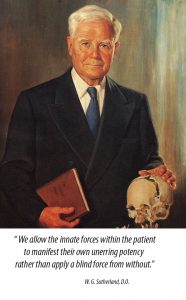Cranial Osteopathy

Osteopathic medicine is to some extent an oral tradition. It has been handed down from teacher to student since Dr. A.T. Still founded the first school of osteopathy in 1890. This continues to be done in one-on-one training sessions. The student has their hands on a fellow student, while the teacher who has an understanding of Dr. Still’s philosophy tries to impart an experience that integrates the philosophy with anatomy and physiology. This is of course done in the setting where the student is immersed in studying embryology, anatomy, physiology. Students of osteopathic medicine are given a wide range of manipulative techniques along with Dr. Stills philosophy. Each osteopathic physician gravitates to whichever approach is most suited to their understanding of Dr. Still’s philosophy. The manipulative techniques that have developed over the years are active or direct and some very passive or indirect. They are all designed to try to bring the body to a point of balance where the inherent forces within the body can begin to express Health.
My interest has primarily been in Dr. William Garner Sutherlands Cranial Concept. Dr. Sutherland was a student of Dr. Still. While he was a student, he was observing a disarticulated, mounted skull, like the one pictured here. While observing the beveling where the bones come together (sutures). He became impressed that these beveled sutures display a design for motion. As he himself put it, he was struck by the thought “beveled like the gills of the fish indicating a primary respiratory mechanism”
Dr. Sutherland, after 30 years of studying this mechanism, was able to demonstrate to his students that there is within the body a mechanism endowed with an inherent motion and driven by the Breath of Life. Dr. Sutherland referred to this as the Primary Respiratory Mechanism, or Primary Respiration. He did not take credit for discovering this. He said, in one of his lectures; “Study the life principal and come closer to understanding what I mean by the ‘Breath of Life.’ Dr. Still did his very best to introduce us to this phenomenon, but we were not ready for it.” “If you read the writings of Dr. Andrew Taylor still carefully, even between the lines, you will find that his thinking was along the same lines. You will find that the cranial concept in the science of osteopathy was his, not mine.” Dr. Sutherland said, “the goal of treatment is to assist the innate forces of the body to find Health and normalize function by allowing the anatomico-physiologic forces within the patient to manifest their own unerring potency.”
As the body moves through different stages of healing and restrictions to the normal expression of movement have been removed, we come to a stage where “All the fluid/tissues become one single entity, one fluid/tissue wave, all responding simultaneously to this unerring potency.” Once we achieve this point of balanced tension within the body, it is then free to begin a therapeutic process that can continue for days or even weeks.
“A thought strikes him that the cerebro-spinal fluid
is one of the highest known elements that are contained in the body,
and unless the brain furnishes this fluid in abundance,
a disabled condition of the body will remain.”
A. T. Still
–